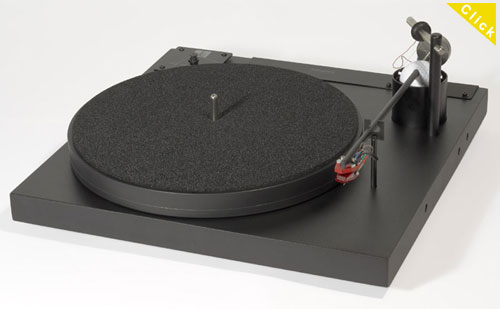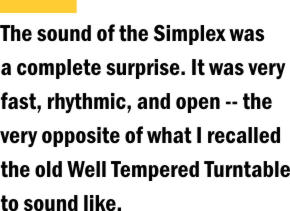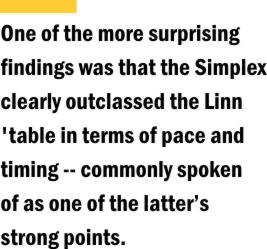Well Tempered Lab • Simplex Turntable
That original Well Tempered Turntable, with a square motor, translucent acrylic platter and stainless-steel tonearm, supplanted a Linn LP-12 in my main system. The sonic differences between the two 'tables were memorable, but I couldn’t say that one was definitively better than the other, so I kept both. The Well Tempered Turntable’s presentation was more substantial -- with greater extension in the bass, lower noise, and solid, well-defined imaging. However, the 'table exhibited a ponderous, closed-in quality. Some of this might have been attributable to the Well Tempered tonearm’s unique paddle-in-a-cup-of-silicone bearing, which could result in overdamping if not set up just right. I was, in fact, so uncomfortable with setting up the 'arm that I changed cartridges only three times over the twelve years that I owned the 'table. That was then, this is Simplex ven though production of the Well Tempered Turntable ceased many years ago, its various iterations have continued to enjoy a loyal following. Founder and chief designer Bill Firebaugh has been at work refining the tonearm around which he built the Turntable in the mid-1980s. In collaboration with Opera Audio of Beijing, a freshly redesigned and rebuilt series of Well Tempered turntables has been brought to market over the past couple of years. All of the new models appear to be pared-down versions of the original designs. The Well Tempered Simplex is the latest and, as its name would imply, simplest addition to this lineup. Nonetheless, the Simplex employs all the key elements that Firebaugh applied to his tonearm and turntable designs in the past. Chief among them is the novel tonearm. Instead of being attached to a mechanical bearing, the Simplex's aluminum armtube passes through a golf ball that is suspended in a cup of high-density silicone. The golf ball is used because it's perfectly spherical, due to close tolerances adhered to during manufacture, and readily available. The golf ball is supported by a nylon filament that is wrapped around a grommet attached to a pillar in front of the silicone cup. An extra half twist of the filament around the grommet results in proper anti-skating -- an ingenious method. Rotating the grommet itself adjusts cartridge azimuth. Loosening set screws at the side of the plinth allows for vertical motion of the silicone cup to vary damping and vertical motion of the suspension pillar and change the vertical tracking angle. Tracking force is applied with conventional counterweights. Despite this complicated description, the new tonearm is much easier to set up and manipulate than the original, although you still must wait for the golf ball to settle into its silicone bath after adjustments are made. The Simplex tonearm has an effective length of 9" and is filled with a fine-grain sand to complement the golf-ball bearing in eliminating spurious resonances. It sports a fixed headshell with two mounting holes, which do not provide for cartridge alignment or overhang adjustment. Firebaugh has successfully mounted 21 different cartridges on the tonearm, so I’m apt to take his word for the universality of this design. An optional finger lift attaches to the headshell. There is no cueing mechanism. The Simplex's platter is acrylic, appears to be the same 30mm thickness as the plinth and comes with a thin foam mat. Gone are the clamps that were a constant of the original 'tables, and there is no central dish in the platter to accommodate the record label, suggesting that the new design obviates the need for close coupling between record and platter -- or that this wasn’t really all that necessary before. As with the older Well Tempered 'tables, the spindle bearing is a "zero clearance" design. The platter rides on the stainless-steel spindle, which inserts into a triangular Teflon hole. Here the round spindle is supported at two asymmetric points laterally and a small pivot point at the bottom. Without the belt attached, the platter would list to the side. Lubricated by 5W-50 synthetic motor oil, this bearing allows for extremely stable and quiet rotation of the platter. The 0.004"-diameter polyester monofilament drive belt looks like a long human hair. It is the product of much experimentation. Unlike the somewhat costly flat polyurethane belts of older models, this belt is easily sourced -- Well Tempered promises users free replacements for life. The manual also describes how to make a new belt, which anyone who has more than 984mm of the monofilament and the ability to tie a knot can do. Also with the new 'tables there is no need for the quirky extra half twist of the belt that was used to reduce flutter. The belt is attached to a pulley on the motor. Manually moving the belt to a different step on the pulley changes the speed -- 33 1/3 and 45 are supported. A wall-wart power supply connects to the Simplex’s small servo-controlled DC motor. Unlike with the older 'tables, where the motor was physically decoupled from the table, here it is mounted within the plinth, albeit encased in isolation material. The plinth is a single 30mm-thick layer of MDF and of much lower mass when compared to the plinths of previous Well Tempered designs. It is supported by four squash balls implanted at the corners. One feature that is retained is the connector block at the back of the 'table, which accepts an RCA-terminated phono cable. Another former Well Tempered owner, Bernard Li of Charisma Audio, the Canadian distributor for Well Tempered and other brands, delivered the Simplex to me. He had the 'table already out of the box and ready to go, so I can't comment firsthand on the packaging or pleasantries of setting the 'table up. I had just removed my reference Brinkmann LaGrange turntable with Breuer Dynamic Type 8 tonearm and the equally massive HRS isolation base the 'table sits on from pride of place atop my Atacama Equinox XL stand to make way for the Simplex. I was surprised at how small and, well, simple this 'table looked. The whole thing felt lighter than the Brinkmann’s motor alone! Bernard had graciously mounted a Denon DL-103R cartridge on the Simplex tonearm, as I am using this same cartridge with a Linn LP-12, which I now listen to sparingly in a second system in a non-critical fashion. I used the 'table here for comparison purposes. The sound of Simplex
This was not a thin and wispy presentation, however. When Sims and his brother Ray enter "Jeep is Jumping" with their horns blazing, the sound was full and present. This quality was even better presented in slower numbers such as "Mr. J.R. Blues," where Ray Sims’ trombone was fully fleshed out. If the Simplex possessed a deficiency, it was in the deep bass where some information might have been left behind in the grooves, John Heard's playing sounding less weighty and visceral. Vocals were pure pleasure. Sufjan Stevens’ "John Wayne Gacy," one of my favorite songs from his brilliant album Illinoise [Asthmatic Kitty Records AKR 014] features a melody that can linger for days. This moody piece has Stevens accompanied only by his guitar and a piano. The quietness of the Simplex made for an arresting quality on this non-audiophile recording. Stevens’ voice and spare accompaniment arose from such a dark background that his haunting lyrics and their deadpan delivery seemed to pop out in better focus, enhancing the creepy quality of this song (and its subject). On more complex material such as the Zoot Sims recording, the low noise floor translated into improved clarity. Individual instrumental lines were more readily delineated, more low-level detail was presented, and images were projected more sharply, as though in bas relief. All of these things were consistent with every record I played, but they were particularly impressive on my torture tests -- a few albums that are prone to distort during loud or complex passages. One example is my half-speed-mastered version of Joni Mitchell’s Court and Spark [Nautilus NR 11], where several cuts -- "Free Man in Paris" and "People’s Parties" especially -- can cause audible mistracking if the 'table is deficient or the setup not spot on. Not only did the Simplex breeze through this album without an inkling of confusion or strain, but a considerable amount of previously unappreciated musical and spatial information was also retrieved. Lest you think this is typical audio-reviewer hyperbole, I urge you to bring one of your personal torture-test LPs to audition on the Simplex and listen for yourself. I'm confident it will sail right along. Pitch instability is a deal-breaker when it comes to turntables, especially belt-driven ones, and piano and nylon-stringed guitar are useful for assessing this. I detected no issues with the Simplex, but I pulled out a couple of audiophile favorites just the same. Laurindo Almeida’s Virtuoso Guitar [Crystal Clear Records CCS 8001] is one of the recordings for which its spectacular sound is not quite matched by the musical content. However, it is a 45rpm LP, and my copy is slightly warped, so it's a useful test record. The Simplex tonearm negotiated the warping with aplomb, and sustained guitar notes were solid, stable and pure. On the other hand musically, Nojima Plays Liszt [Reference Recordings RR-25] is a superb solo piano recording where the music and its performance are commensurate with the sound. I heard no wavering or warbling of piano notes here. Rather, the Simplex yielded such enhanced resolution of detail and microdynamics that I was left sitting transfixed throughout the entire recording, interrupted only to get off the couch to flip sides. I’ll spare you more audiophile verbiage and simply state that I’ve never heard this record sound better. The Simplex's pitch accuracy led to an unerring sense of rhythmic drive, and its low self-induced noise gave all music a sense of speed and clarity. While the price of the Well Tempered Simplex fits within the semi-budget range of belt-drive audiophile turntables, its performance certainly did not. Simplex vs. not so Simplex inserted my Linn LP-12 into the system several times while I was listening to the Simplex. This is the same LP-12 and Ittok LVII tonearm I have owned for some 25 years. It has had occasional maintenance, but other than a Lingo 2 power supply, there have been no upgrades. Even on the used market, an older Lingo'd Linn LP-12 with tonearm would cost more than what the Simplex does brand new.
I did not do any direct A/B comparisons with my ten-times-as-costly Brinkmann LaGrange/Breuer Dynamic Type 8 setup with which I use a ZYX Universe S cartridge. I can say that I am thankful that I did not have to do any blind testing with it and the Simplex. While I think I might have been able to distinguish one from the other -- for example, the Brinkmann will dig deeper into the bass, and its noise floor is vanishingly low, thus allowing for explosive reproduction of transients -- I’m not sure that I wouldn’t have favored the Simplex for its open and spirited presentation and sheer musicality. That's saying a great deal for a $2000 turntable. Simplex in sum he Well Tempered Simplex runs counter to my intuition that over-engineering and high mass are necessary to squeeze the most out of vinyl playback, and it underscores the importance of squelching resonances at the tonearm and noise at the spindle bearing in creating a black background. It also proves that the motor, belt and platter are vital to re-creating music that is pure in tone and definition. The Simplex successfully addresses these facets in unique and innovative ways that have clearly been improved upon over the past 25 years, and it does so with surprising effectiveness given its price. The Simplex isn’t inexpensive; however, when one considers the current replacement cost of my Linn LP-12 or the price of today’s über decks, the Simplex would not be considered out of line -- and it might well be thought of as a bargain when its performance is considered. I’ve not listened to the Simplex’s more expensive stable mates, the Amadeus and Amadeus GTA. They feature 10 1/2" tonearms and more complex plinths, but the essential bits appear to be the same. The entry-level Simplex just might represent the sweet spot in this lineup, but this is pure conjecture -- and part tease. As someone who owns equipment from the likes of Nagra,
Brinkmann, and Tidal Audio, I must say that a turntable that uses golf and squash balls,
an MDF plinth, and a wall-wart power supply gives me pause for thought. However, if you
value and respect countless hours of experimentation and outside-the-box thinking, and if
you are mainly outcome-orientated, this could be your 'table. In fact, if you enjoy
listening to records at all, a demo of the Simplex is certainly worth your time. It just
might change your beliefs regarding analog playback -- just as it did for me.
|


 ne of the first records I
listened to on the Simplex was an old favorite, The Swinger [Pablo 2310 861],
featuring tenor saxophonist Zoot Sims with various sidemen, including Shelley Manne on
drums and John Heard on bass. The sound of the Simplex was a complete surprise. It was
very fast, rhythmic, and open -- the very opposite of what I recalled the old Well
Tempered Turntable to sound like. Admittedly aural memory can be fleeting, especially when
compounded by differences in ancillaries and listening environments, but I stand by these
impressions, so obvious were they to me. "Jeep is Jumping" is an up-tempo cut
from The Swinger that moved along at a very nice clip. Heard’s bass line was
readily intelligible, quick and free of smearing. Jimmy Rowles’ piano notes sparkled
with an impressive speed of attack. The drum sounds were particularly crisp and cymbal
decays were naturally extended.
ne of the first records I
listened to on the Simplex was an old favorite, The Swinger [Pablo 2310 861],
featuring tenor saxophonist Zoot Sims with various sidemen, including Shelley Manne on
drums and John Heard on bass. The sound of the Simplex was a complete surprise. It was
very fast, rhythmic, and open -- the very opposite of what I recalled the old Well
Tempered Turntable to sound like. Admittedly aural memory can be fleeting, especially when
compounded by differences in ancillaries and listening environments, but I stand by these
impressions, so obvious were they to me. "Jeep is Jumping" is an up-tempo cut
from The Swinger that moved along at a very nice clip. Heard’s bass line was
readily intelligible, quick and free of smearing. Jimmy Rowles’ piano notes sparkled
with an impressive speed of attack. The drum sounds were particularly crisp and cymbal
decays were naturally extended. One of the more surprising
findings was that the Simplex clearly outclassed the Linn 'table in terms of pace and
timing -- commonly spoken of as one of the latter’s strong points. The Linn setup
imbued the music with a richer and warmer tonal balance, particularly in the lower
midrange and below. But when compared to the Simplex, the Linn 'table presented the music
in a somewhat homogenized fashion, while the Well Tempered 'table sounded considerably
more articulate and resolute from top to bottom.
One of the more surprising
findings was that the Simplex clearly outclassed the Linn 'table in terms of pace and
timing -- commonly spoken of as one of the latter’s strong points. The Linn setup
imbued the music with a richer and warmer tonal balance, particularly in the lower
midrange and below. But when compared to the Simplex, the Linn 'table presented the music
in a somewhat homogenized fashion, while the Well Tempered 'table sounded considerably
more articulate and resolute from top to bottom.